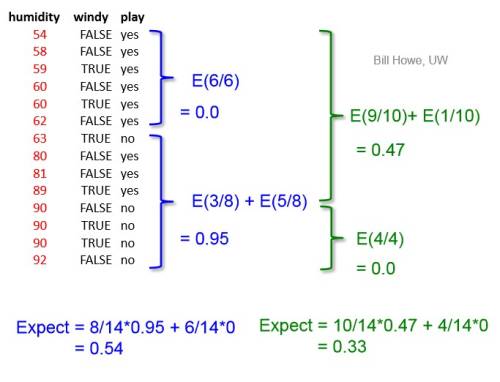About
Information theory was find by Claude Shannon. It has quantified entropy. This is key measure of information which is usually expressed by the average number of bits needed to store or communicate one symbol in a message.
Information theory measure information in bits
<math> entropy(p_1,p_2,\dots,p_n)=-{p_1}log(p_1)-{p_2}log(p_2)-\dots-{p_n}log(p_n) </math>
Information gain is the amount of information gained by knowing the value of the attribute
<math> \text{Information gain} = \text{(Entropy of distribution before the split)} – \text{(entropy of distribution after it)} </math>
Information gain is the amount of information that's gained by knowing the value of the attribute, which is the entropy of the distribution before the split minus the entropy of the distribution after it. The largest information gain is equivalent to the smallest entropy.
Articles Related
Overfitting
An highly branching attributes such as an ID attribute (which is the Extreme case with one different Id by case) will give the maximal information gain but will not Machine Learning - (Overfitting|Overtraining|Robust|Generalization) (Underfitting) at all and will then lead to an algorithm that overfit.
Steps to calculate the highest information gain on a data set
With the Weather data set
Entropy of the whole data set
14 records, 9 are “yes”
Expected new entropy for each attribute
outlook
The outlook attribute contains 3 distinct values:
- overcast: 4 records, 4 are “yes”
- rainy: 5 records, 3 are “yes”
- sunny: 5 records, 2 are “yes”
Expected new entropy:
temperature
| Distinct value | Yes records | Entropy |
|---|---|---|
| cool | 4 records, 3 are “yes” | 0.81 |
| rainy | 4 records, 2 are “yes” | 1.0 |
| sunny | 6 records, 4 are “yes” | 0.92 |
Expected new entropy:
humidity
discrete values
| Distinct value | Yes records | Entropy |
|---|---|---|
| normal | 7 records, 6 are “yes” | 0.59 |
| high | 7 records, 2 are “yes” | 0.86 |
Expected new entropy:
continues values
Consider every possible binary partition; choose the partition with the highest gain
windy
| Distinct value | Yes records | Entropy |
|---|---|---|
| TRUE | 8 records, 6 are “yes” | 0.81 |
| FALSE | 5 records, 3 are “yes” | 0.97 |
Expected new entropy:
Gain
| Attribute | Information Gain |
|---|---|
| outlook | 0.94 - 0.69 = 0.25 |
| temperature | 0.94 - 0.91 = 0.03 |
| humidity | 0.94 - 0.72 = 0.22 |
| windy | 0.94 - 0.87 = 0.07 |
The highest information gain is with the outlook attribute.
Documentation / Reference
- Bill Howe University of Washington, Coursera, Introduction to data science


